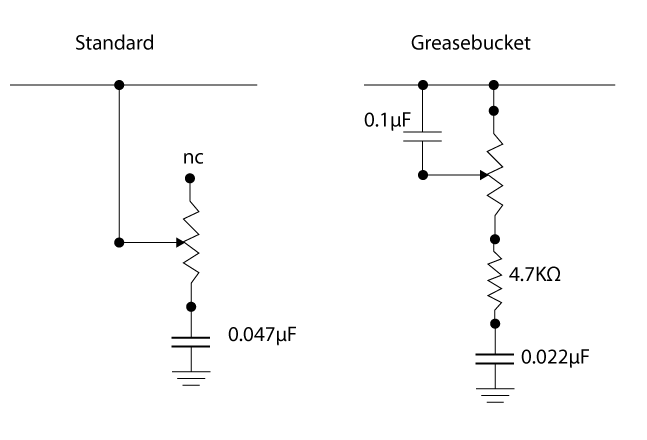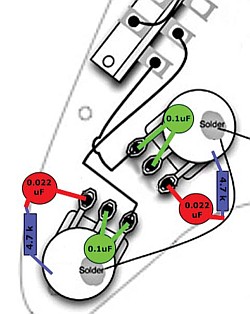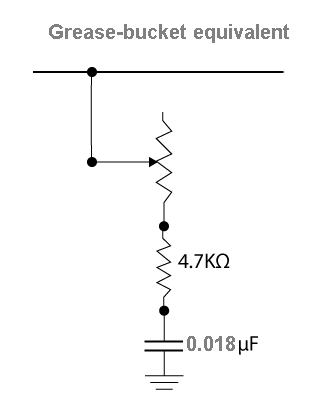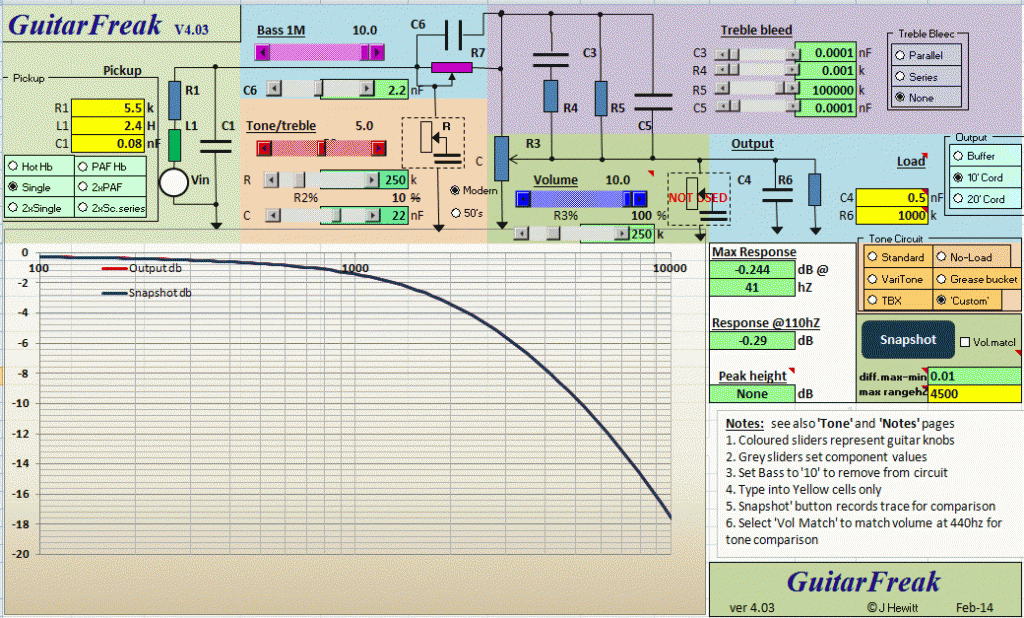|
|
Post by JohnH on Feb 24, 2014 7:04:57 GMT -5
The 'Greasebucket' tone control
This is another Fender variant, like most of the more colourfully named tone circuits.
It is the stock tone-control system on several popular recent and current models, such as Highway One's, and American Special's, and also some basses.
I had this on the bridge and neck pickups of my Am Special Strat when I got it, and in the specs, Fender describes its action as: 'Rolls Off Highs without Adding Bass', which is a bit mysterious.
Here is a schematic, compared to a standard tone control:

And this is how a pair might be wired in a Strat.

Thcircuit consists of a 250k pot, a 0.022uF cap, plus another 0.1uF cap, between the centre and outer pot lugs, and a 4.7k fixed resistor in series. At high settings, it acts as a normal tone control, with the 4.7k adding a relatively small extra resistance. Only the 0.022uF cap is active at maximum, but at these settings, the cap is not important anyway.
At low settings, both caps are active in series, with the 0.1uF cap bypassed by the maximum resistance of the pot.
Tthe main noticeable difference from a standard tone control occurs at these minimum knob positions, where the extra 4.7k resistor effectively stops the control going to the usual minimum, with it's mid-range honk. It might be that this is what Fender means when it refers to 'not adding bass'.
Here is a graph at each knob setting:

There is a slight mid-peak at minimum, but much less than usual.
It occurred to me that the tone effect might be very much equivalent to a standard control, using a smaller cap and a series resistor, like this:

Note that 0.1uF and 0.022uf in series equate to 0.018uF
I tested that with the spreadsheet, comparing this equivalent to the basic Fender Greasebucket wiring, and it is indeed identical to within 0.02db at all settings and all frequencies up to 4.5kHz. Clearly, there has to be some slight difference from the different configuration, but the numbers show that it is not significant.
This system, in original or equivalent form, would be good for those who find a good tone at low settings just short of minimum, and don't want the '0' tone. With the Greasebucket control, such a tone is easier to find quickly, and the other tones are a bit more spread out. If you think of the equivalent version, you can select a tone cap freely for what you want, without needing to think of two caps and their combination. Also, the equivalent version could have a no-load pot too, if desired.
So, the Greasebucket control is fine if you like what it does. I didn't keep mine though.
|
|
|
|
Post by sumgai on Feb 24, 2014 12:49:19 GMT -5
John, You didn't include 5spice or G-Freak graphs for your second variant, so I'm not sure here, but.... While there is an overall negligible difference, there is some difference nonetheless. Consider: The 0.1µf is in parallel with part of that pot (I'll go with your relaxed definition, your reasoning is sound). While the control is turned away from the extreme ends, the signal is still traveling through both paths, cap and part of the resistor in parallel. As predicted, the higher frequencies will have an easier time of it through the cap, but those lower freqs are still gonna make it through the resistor, at least until the resistance is great enough to reduce that passage to inaudability. This is because the upper leg is also connected to the signal "hot" line, instead of being disconnected as is the usual case. I have a pretty strong feeling that if you chart the response curve for your modified circuit, you'll find little or no "mid-range hump" as you do see in the full-fledged version. To my mind, small as that difference might be, it's likely to be audible to most players who are looking for it. Or I could be all washed up, who knows....  sumgai |
|
|
|
Post by JohnH on Feb 24, 2014 14:24:06 GMT -5
John, You didn't include 5spice or G-Freak graphs for your second variant, so I'm not sure here, but.... While there is an overall negligible difference, there is some difference nonetheless. Consider: The 0.1µf is in parallel with part of that pot (I'll go with your relaxed definition, your reasoning is sound). While the control is turned away from the extreme ends, the signal is still traveling through both paths, cap and part of the resistor in parallel. As predicted, the higher frequencies will have an easier time of it through the cap, but those lower freqs are still gonna make it through the resistor, at least until the resistance is great enough to reduce that passage to inaudability. This is because the upper leg is also connected to the signal "hot" line, instead of being disconnected as is the usual case. I have a pretty strong feeling that if you chart the response curve for your modified circuit, you'll find little or no "mid-range hump" as you do see in the full-fledged version. To my mind, small as that difference might be, it's likely to be audible to most players who are looking for it. Or I could be all washed up, who knows....  sumgai I didn't plot another graph to show the 'equivalent' circuit, because it really is so close it is identical for all practical (and audible) purposes. The differences are less than 0.02db, and anything less than 1 db is hardly significant. But here is a plot of the original Greasebucket and the 'Greasebucket equivalent', at a tone pot setting of 5:  The difference is reported in a box at the right, as the max + difference added to the max - difference across the frequency range. There are indeed two traces there, red and dark blue. But the red is almost completely covered by the blue, except for a few pixels at upper left. The same is true at all other knob settings (I checked). I think it is surprising, and suggests that here is one small element of a Fender design that has not been quite fine tuned for most efficient production. Ill take 1c commission for each cap that Fender can save! |
|
|
|
Post by reTrEaD on Feb 24, 2014 19:21:41 GMT -5
What have we learned here?
1 - If you like the midrange peak when the tone control is at minimum, just use a standard tone control configuration
2 - If you don't like the peak, add a fixed resistor to eliminate or minimize the peak. (season to taste)
3 - If you don't get a deep enough treble cut after adding a fixed resistor, use a larger cap.
Sound about right?
|
|
|
|
Post by sumgai on Feb 25, 2014 2:12:17 GMT -5
John,
Your most recent graph is what I expected, moreso than that with a small hump when the GreasyThing is cut all the way down to 1 on the knob. That "minimum" hump is what I was referring to, not the middle/upper range of the control. Admittedly, most players don't reduce all the treble very often, but some do, and more than once I've seen a player with only a small value cap, ala the famed "woman tone" setup - those are the kinds of folks who do indeed turn the tone (treble) down all the way, or perhaps somwhere in the middle, and not very often to they need to "open her up" with the knob set to 10.
Now I'm not suggesting that something/anything's wrong here, I'm only saying that there's always some small portion of the playing populace that will prefer that nether region over what the rest of use on a daily basis. It's in the interest of letting them play along with the rest of us that I speak up, that's all.
HTH
sumgai
|
|
|
|
Post by JohnH on Feb 25, 2014 15:22:40 GMT -5
What have we learned here? 1 - If you like the midrange peak when the tone control is at minimum, just use a standard tone control configuration 2 - If you don't like the peak, add a fixed resistor to eliminate or minimize the peak. (season to taste) 3 - If you don't get a deep enough treble cut after adding a fixed resistor, use a larger cap. Sound about right? Yes pretty much. The other thing that a fixed resistor does is to keep a hint of the upper frequencies present. Once all resistance is gone, we get the full interaction of cap with pickup inductance, which falls at 12db per octave at frquencies above the peak. As the pot or fixed resistor becomes engaged, the tone changes transition to more of an RC filter, with a 6db per octave slope. Sumgai - let me know if you think any more graphs would help here. Easy to do, but I think its covered. As to that equivalent circuit, it really does look exactly the same at all frequencies and knob settings, including at and near minimum. I'm now moving on to getting my head around figuring out the mighty 'TBX' control. I'm sure that will generate some discussion. It makes the Greasebucket look like Potted Shrimp! |
|
|
|
Post by reTrEaD on Feb 25, 2014 18:57:18 GMT -5
I've never used a TBX so I wonder how mighty it really is. Complicated for sure. From what I've read it has a ganged pot that's tricked out with one element having zero resistance from CCW to the center-detent and increasing resistance from there to CW. The other element is no-load from CW to center-detent then decreasing resistance to zero as you move toward CCW.
On paper, it looks like snake oil to me. The 'normal' center-detent position has a tone-choking 82K resistor directly in parallel with the signal. Naturally, rotating the control CW from there would make it seem like it's 'expanding' the tone.
Maybe I'm missing something and it actually does something worth doing?
|
|
|
|
Post by JohnH on Feb 25, 2014 20:46:01 GMT -5
ReT..yes indeed on the TBX. Hold that thought, I'll have a thread up about it in a couple of days.
|
|
|
|
Post by pablogilberto on Jun 13, 2020 18:16:38 GMT -5
Hello! From the diagram above shared by JohnH, The Tone Control of the Greasebucket on the strat connects to the input (left lug) of the volume pot via switch. I also found some Greasebucket diagram which connects the tone control to the output (middle lug) of the volume pot. Can you enlighten me on this? Thank you! |
|











